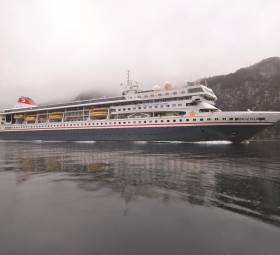Displaying items by tag: ABP Ports, Barrow
Cruiseship's Second Inaugural Irish Sea Port of Call
#CruiseFirsts - Irish Sea port of Barrow-in-Furness, operated by Associated British Ports / ABP Ports welcomed the largest cruise vessel ever to call to the Cumbrian port in north-west England.
MS Braemar became the second cruiseship to visit Barrow in the last two months, when the Fred. Olsen Cruise ship made an inaugural call last Friday. The 196m in length cruiseship which too made a first call to Rosslare Europort last month, can accommodate over 900 passengers, making it the largest cruise ship to visit since the port’s first cruise call in 1995.
While cruise ships are today not a regular sight at the Port of Barrow, the port has a long association with the industry dating back 100 years, including when the then Vickers-Armstrongs shipyard built the ‘Strath’ Class Liners for the Peninsular & Oriental Steam Navigation Company (P&O) in the 1930s.
Port Manager Paul Jervis said: “The Port of Barrow is best known today for its role as a base for manufacturing submarines. However, the arrival of MS Braemar, following the visit of the Saga Pearl II last month shows that the port is capable of handling a wide variety of vessels for different customers.
“The benefit of hosting cruise vessels here at Barrow is that we are able to showcase Barrow and the Lake District area to tourists from all over the UK and the world. It boosts the region’s profile and tourist numbers, and will provide economic benefit to the local communities.
“The area has a lot of attractions to entice cruise companies and their passengers. With the port well equipped to handle cruise calls, we hope to see more cruise ships at Barrow in the future.”
Scheduled shore excursions included tours of the Lake District and free shuttle buses available to take passengers to local attractions like the Dock Museum and Furness Abbey.





























































